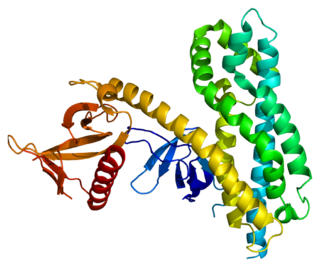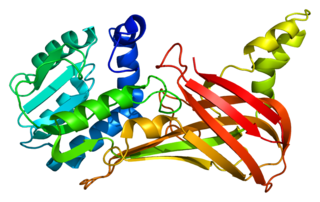Related Research Articles

Lamin B2 is a protein that in humans is encoded by the LMNB2 gene. It is the second of two type B nuclear lamins, and it is associated with laminopathies.
RhoU is a small signaling G protein, and is a member of the Rho family of GTPases. Wrch1 was identified in 2001 as encoded by a non-canonical Wnt induced gene. RhoU/Wrch delineates with RhoV/Chp a Rho subclass related to Rac and Cdc42, which emerged in early multicellular organisms during evolution.

General transcription factor 3C polypeptide 5 is a protein that in humans is encoded by the GTF3C5 gene.

STAGA complex 65 subunit gamma is a protein that in humans is encoded by the SUPT7L gene.

Rho guanine nucleotide exchange factor 4 is a protein that in humans is encoded by the ARHGEF4 gene.

Protein arginine N-methyltransferase 3 is an enzyme that in humans is encoded by the PRMT3 gene.

Integrator complex subunit 12 (Int12) also known as PHD finger protein 22 (PHF22) is a protein that in humans is encoded by the INTS12 gene.

Mitochondrial methionyl-tRNA formyltransferase is a protein that in humans is encoded by the MTFMT gene.

Eukaryotic translation initiation factor 4E family member 3 is a protein that in humans is encoded by the EIF4E3 gene.

NOP2/Sun domain family, member 2 is a protein that in humans is encoded by the NSUN2 gene. Alternatively spliced transcript variants encoding different isoforms have been noted for the gene.
Protein arginine methyltransferase 8 is a protein that in humans is encoded by the PRMT8 gene. Arginine methylation is a posttranslational modification involved in a number of cellular processes, including DNA repair, RNA transcription, signal transduction and protein compartmentalization. PRMT8 binds and dimethylates Ewing sarcoma breakpoint region 1 (EWS) protein.

DIP2 disco-interacting protein 2 homolog B (Drosophila) is a protein that in humans is encoded by the DIP2B gene. A member of the disco-interacting protein homolog 2 protein family, it contains a binding site for the transcriptional regulator DNA methyltransferase 1 associated protein 1, as well as AMP-binding sites. The presence of these sites suggests that DIP2B may participate in DNA methylation. This gene is located near a folate-sensitive fragile site.
Solute carrier family 25, member 29 is a protein that in humans is encoded by the SLC25A29 gene. The gene is also known as CACL and C14orf69. SLC25A29 belongs to a protein family of solute carriers called the mitochondrial carriers.
Protein arginine methyltransferase 7 is a protein that in humans is encoded by the PRMT7 gene. Arginine methylation is an apparently irreversible protein modification catalyzed by arginine methyltransferases, such as PMT7, using S-adenosylmethionine (AdoMet) as the methyl donor. Arginine methylation is implicated in signal transduction, RNA transport, and RNA splicing.
Ankyrin repeat and sterile alpha motif domain containing 4B is a protein that in humans is encoded by the ANKS4B gene. The gene is also known as HARP. Ankyrin repeats mediate protein-protein interactions in very diverse families of proteins.
Asteroid homolog 1 (Drosophila) is a protein that in humans is encoded by the ASTE1 gene. The gene is also known as HT001.
Glutamyl-tRNA(Gln) amidotransferase, subunit C homolog (bacterial) is a protein that in humans is encoded by the GATC gene. The gene is also known as 15E1.2 and encodes part of a Glu-tRNA(Gln) amidotransferase enzyme.
Family with sequence similarity 104, member A is a protein that in humans is encoded by the FAM104A gene. The orthologous gene in mice is also known as D11Wsu99e.

Chromosome 2 open reading frame 54, otherwise known as Mab21L4, is a protein that in humans is encoded by the C2orf54 gene. The orthologue in mice is 2310007B03Rik.

RNA binding motif protein 47 is a protein in humans that is encoded by the RBM47 gene in chromosome 4.
References
- 1 2 "RNA (guanine-9-) methyltransferase domain containing 2" . Retrieved 2011-12-06.
- ↑ "Clinical chemistry data for Rg9mtd2". Wellcome Trust Sanger Institute.
- 1 2 3 Gerdin AK (2010). "The Sanger Mouse Genetics Programme: High throughput characterisation of knockout mice". Acta Ophthalmologica. 88: 925–7. doi:10.1111/j.1755-3768.2010.4142.x. S2CID 85911512.
- ↑ Mouse Resources Portal, Wellcome Trust Sanger Institute.
- ↑ "International Knockout Mouse Consortium".
- ↑ "Mouse Genome Informatics".
- ↑ Skarnes, W. C.; Rosen, B.; West, A. P.; Koutsourakis, M.; Bushell, W.; Iyer, V.; Mujica, A. O.; Thomas, M.; Harrow, J.; Cox, T.; Jackson, D.; Severin, J.; Biggs, P.; Fu, J.; Nefedov, M.; De Jong, P. J.; Stewart, A. F.; Bradley, A. (2011). "A conditional knockout resource for the genome-wide study of mouse gene function". Nature. 474 (7351): 337–342. doi:10.1038/nature10163. PMC 3572410 . PMID 21677750.
- ↑ Dolgin E (2011). "Mouse library set to be knockout". Nature. 474 (7351): 262–3. doi: 10.1038/474262a . PMID 21677718.
- ↑ Collins FS, Rossant J, Wurst W (2007). "A Mouse for All Reasons". Cell. 128 (1): 9–13. doi: 10.1016/j.cell.2006.12.018 . PMID 17218247. S2CID 18872015.
- ↑ van der Weyden L, White JK, Adams DJ, Logan DW (2011). "The mouse genetics toolkit: revealing function and mechanism". Genome Biol. 12 (6): 224. doi:10.1186/gb-2011-12-6-224. PMC 3218837 . PMID 21722353.